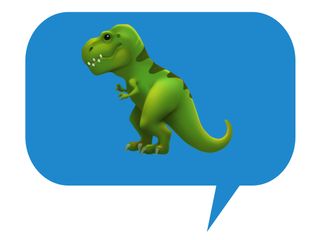6 Ways Apple Messed Up Its T. Rex Emoji

Apple's new green-and-toothy Tyrannosaurus rex emoji may be cute, but its anatomy is wildly inaccurate, a paleontologist told Live Science.
For starters, its lower teeth shouldn't be visible, and its ear and nostril are in the wrong places, said Thomas Carr, a vertebrate paleontologist and an associate professor of biology at Carthage College in Wisconsin.
Carr would know: He's helped describe several tyrannosaurs — including Daspletosaurus horneri, Teratophoneus curriei, Bistahieversor sealeyi and Appalachiosaurus montgomeriensis — all of which lived during the late Cretaceous period, before the 6-mile-wide (10 kilometers) asteroid slammed into Earth, killing the nonavian dinosaurs. [Gory Guts: Photos of a T. Rex Autopsy]
Carr noted several problems with Apple's new dinosaur emoji, which the company previewed on World Emoji Day (July 17) and plans to make available to users later this year, along with several other new emojis, such as a zombie and a "mind-blown" face. Carr listed a half dozen ways the T. rex emoji is imprecise:
- In the emoji, the dino's eyes are above the snout, but in dinosaurs, including T. rex, the eyes are actually on the side of the head.
- In tyrannosaurs, the lower teeth are never in view when the jaws are closed, unlike those on Apple's emoji.
- The emoji's arms are too spindly.
- The ear is in the wrong place; it should be above the jaw joint.
- The shape of the head is wrong — it looks like the emoji creators followed the inaccurate depiction of T. rex from the "Jurassic Park" movies.
- The nostril is in the wrong place; it should be close to the front of the snout.
When asked whether he'd use the T. rex emoji, Carr did not mince his words.
"Unfortunately, not this version," Carr told Live Science in an email. "I'd use an accurate avatar."
Rather, he'd like to see "basic anatomical accuracy, especially skull shape, which lends the animals much of their identity and personality."
Sign up for the Live Science daily newsletter now
Get the world’s most fascinating discoveries delivered straight to your inbox.
This is Apple's first dinosaur emoji, if you don't count the birds, which evolved from dinosaurs and are technically considered living dinosaurs.
But Apple might have gotten at least one thing right: It didn't give T. rex lips, as some researchers (most likely inaccurately) suggested the mega-beast sported. (In fact, Carr and colleagues' D. horneri finding suggested that T. rex likely didn't pucker up.)
The new emoji is also a step up from Barney, the purple T. rex that has entertained children on television for years.
"The lesson here is that it isn't hard to get dinosaurs right — it just requires a bit of attention and expert input to draft a stylized, but accurate, icon," Carr said. He added that if Apple is looking for dinosaur emoji suggestions, the 75-million-year-old Daspletosaurus horneri would be a fearsome pick.

Apple did not immediately respond to comment about the accuracy of its T. rex, but Live Science will update the story if the company replies.
Original article on Live Science.

Laura is the archaeology and Life's Little Mysteries editor at Live Science. She also reports on general science, including paleontology. Her work has appeared in The New York Times, Scholastic, Popular Science and Spectrum, a site on autism research. She has won multiple awards from the Society of Professional Journalists and the Washington Newspaper Publishers Association for her reporting at a weekly newspaper near Seattle. Laura holds a bachelor's degree in English literature and psychology from Washington University in St. Louis and a master's degree in science writing from NYU.

